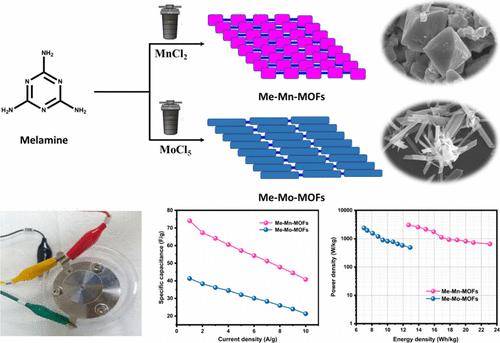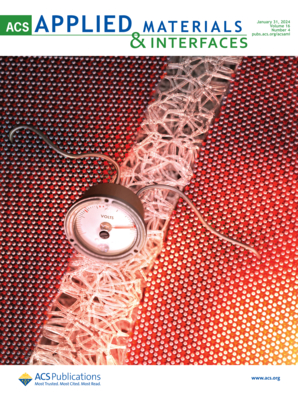Specific Capacitance Enhancement of Metal–Organic Framework (MOF) by Boosting Intramolecular Charge Transfer Mechanism
IF 8.3
2区 材料科学
Q1 MATERIALS SCIENCE, MULTIDISCIPLINARY
引用次数: 0
Abstract
Energy storage is very important for the forthcoming future; hence, the overview of innovative materials in this research area is necessary. Here, two metal–organic framework (MOF) materials are described thoroughly, which is highly required because few MOFs are available only on high-performance supercapacitors. The melamine-, manganese-, and molybdenum-based MOF materials, such as Me-Mn-MOFs and Me-Mo-MOFs, were prepared and applied for supercapacitor applications. The MOF materials are validated and characterized using conventional characterization procedures. The physicochemical properties of the materials were analyzed through sophisticated instrumental analysis. The surface morphological results reveal that the melamine and manganese-based MOFs (Me-Mn-MOFs) display a cubic-like structure, whereas the melamine and molybdenum-based MOFs (Me-Mo-MOFs) portray rod-like structures. The P-XRD, XPS, and BET results confirm the formation of the MOF materials from the starting materials. The electrochemical analysis reveals that the prepared materials could be a potential material for high-performance supercapacitor applications. The specific capacitances of Me-Mn-MOFs and Me-Mo-MOFs are 653.54 and 312.63 F/g. The asymmetric devices demonstrate that the power densities of Me-Mn-MOFs and Me-Mo-MOFs are 3048.7 and 2376.6 W/kg. The suggested materials could provide an original viewpoint on MOFs for use in high-performance supercapacitor applications.

通过促进分子内电荷转移机制增强金属有机框架 (MOF) 的比电容
储能对于即将到来的未来非常重要,因此有必要对这一研究领域的创新材料进行概述。本文对两种金属有机框架(MOF)材料进行了详尽介绍,这一点非常必要,因为目前只有少数 MOF 可用于高性能超级电容器。制备了三聚氰胺、锰和钼基 MOF 材料,如 Me-Mn-MOFs 和 Me-Mo-MOFs,并将其应用于超级电容器。采用常规表征程序对 MOF 材料进行了验证和表征。通过复杂的仪器分析,对材料的理化性质进行了分析。表面形貌结果显示,三聚氰胺和锰基 MOFs(Me-Mn-MOFs)呈现立方体结构,而三聚氰胺和钼基 MOFs(Me-Mo-MOFs)则呈现棒状结构。P-XRD、XPS 和 BET 结果证实了这些 MOF 材料是由起始材料形成的。电化学分析表明,所制备的材料可能成为高性能超级电容器应用的潜在材料。Me-Mn-MOFs 和 Me-Mo-MOFs 的比电容分别为 653.54 和 312.63 F/g。不对称器件表明,Me-Mn-MOFs 和 Me-Mo-MOFs 的功率密度分别为 3048.7 和 2376.6 W/kg。所建议的材料为 MOFs 在高性能超级电容器中的应用提供了新的视角。
本文章由计算机程序翻译,如有差异,请以英文原文为准。
求助全文
约1分钟内获得全文
求助全文
来源期刊

ACS Applied Materials & Interfaces
工程技术-材料科学:综合
CiteScore
16.00
自引率
6.30%
发文量
4978
审稿时长
1.8 months
期刊介绍:
ACS Applied Materials & Interfaces is a leading interdisciplinary journal that brings together chemists, engineers, physicists, and biologists to explore the development and utilization of newly-discovered materials and interfacial processes for specific applications. Our journal has experienced remarkable growth since its establishment in 2009, both in terms of the number of articles published and the impact of the research showcased. We are proud to foster a truly global community, with the majority of published articles originating from outside the United States, reflecting the rapid growth of applied research worldwide.
 求助内容:
求助内容: 应助结果提醒方式:
应助结果提醒方式:


